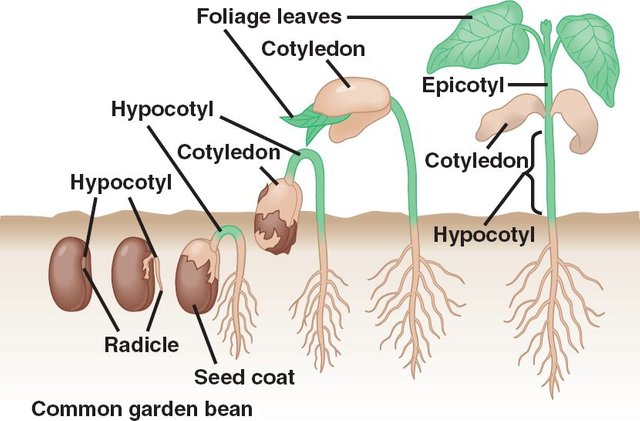SEED GERMINATION
The simplest way to understand the germination of seeds in plant is to think of it as its transition from childhood into adulthood. We have already learned that seeds contain embryonic roots, stems, and leaves, and enough food to keep the plant growing until it has the ability to produce its own food through photosynthesis.

image source: https://s-media-cache-ak0.pinimg.com/originals/a0/6f/91/a06f9158b2e01bda67811c6099dcade3
Seed Formation
Plants reproduce using eggs and sperm, just like people. However, they don't have physical sex! Male plants release pollen, which fertilizes the ovary. The fertilized ovaries develop into seeds, which can then be distributed to make new plants. As the fertilized ovaries develop, a surplus of carbohydrates and proteins are stored inside the seed. This will serve as food for the plant until it can develop leaves. Next, the fertilized plant ovaries develop the hardened coat we see as the outside of seeds to protect them against harsh environmental conditions. The seeds then can be carried away by wind or animals to create new plants.

image source: https://s-media-cache-ak0.pinimg.com/originals/a0/6f/91/a06f9158b2e01bda67811c6099dcade3
Process of Seed Germination
• Water: it is extremely necessary for the germination of seeds. Some seeds are extremely dry and need to take considerable amount of water, relative to the dry weight of the seed. But most seeds need enough water to moisten and not soak. It also leaches away a germinator inhibitor in the seed.
• Oxygen: It is required by the germinating seed for metabolism. It is used as a part of aerobic respiration until it manages to grow green leaves of its own. Oxygen can be found in the pores of sand particles, but if the seed is buried too deep it will be deprived of this oxygen.
• Temperature: This affects growth rate as well as metabolism of the seed. Quite obviously different seeds require different optimum temperatures.
• Light or darkness: This can act as an environmental trigger. Many seeds refuse to germinate until sunlight falls on them.
STEPS IN SEED GERMINATION
- Imbibition
The first step in the seed germination is imbibition i.e. absorption of water by the dry seed. Imbibition results in swelling of the seed as the cellular constituents get rehydrated. The swelling takes place with a great force. It ruptures the seed coats and enables the radicle to come out in the form of primary root.
Imbibition is accomplished due to the rehydration of structural and storage macromolecules, chiefly the cell wall and storage polysaccharides and proteins. Many seeds contain additional polysaccharides, not commonly found in vegetative tissues. Seeds packed dry in a bottle can crack it as they imbibe water and become swollen.
- Latent phase
The food material inside the seed, now in presence of water provide sufficient energy. This helps the embryo to sprout out of the seed as a seedling. There is an internal active metabolism for the seed. This is a bit long time-consuming process so it remains latent. The metabolic reaction is active and there is a release of heat. This stage makes the seed ready to sprout out.
- Respiration
Imbibition of water causes the resumption of metabolic activity in the rehydrated seed. Initially, their respiration may be anaerobic (due to the energy provided by glycolysis) but it soon becomes aerobic as oxygen begins entering the seed. The seeds of water plants, as also rice, can germinate under water by utilizing dissolved oxygen.
REFERENCE
http://byjus.com/biology/seed-germination
http://study.com/academy/lesson/what-is-seed-germination-definition-process-steps-factors
http://www.tutorvista.com/content/biology/biology-iv/plant-growth-movements/seed-germination-process.php
@geeboy